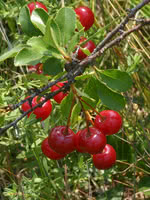Mon-Fri 9am - 5pm Mountain time
Western Snowberry vs Mongolian Cherry
Symphoricarpos occidentalis
Prunus fruticosa
NOT AVAILABLE THIS SEASON - MIGHT RETURN
CUSTOM GROW
Like the Common Snowberry, the Western Snowberry is a small shrub with pink flowers useful for feeding livestock and preventing erosion. Unlike the common species, however, the Western Snowberry is much more suited to wet conditions, capable of persevering through poor soil drainage and occasional flooding.
After the Snowberry's flowers have bloomed, it produces berries which often last on the plant through winter. These berries are toxic to humans, but livestock and local wildlife love them! Those hoping to attract wildlife to their property can plant Snowberry and expect to see animals foraging on it much later in the year than other plants.
Mongolian Cherry is a hardy shrub that is often grown as an ornamental. This plant makes an attractive flowering hedgerow that requires little maintenance. The dark red cherries are tart and desirable for baking, wine-making, and canning. This shrub is popular with wildlife.
Western Snowberry Quick Facts
Mongolian Cherry Quick Facts
Toxicity: berries are toxic to humans

